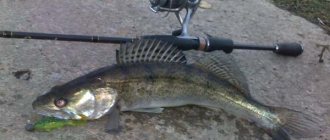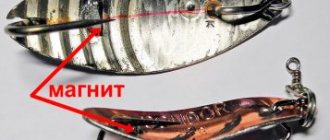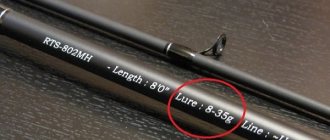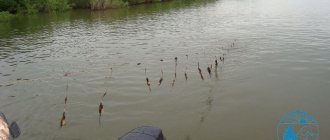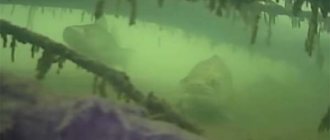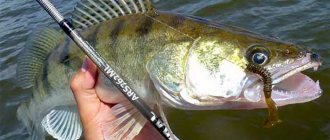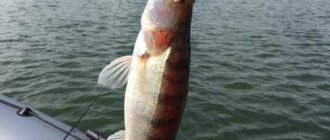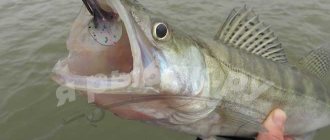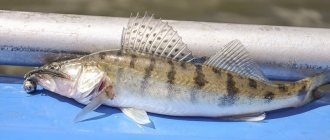But this does not mean at all that when casting, the pike perch will immediately attack the bait. The fish bite is greatly influenced by several factors, including natural ones. Atmospheric indicators, such as atmospheric pressure, ambient temperature, water temperature, wind direction, etc., are especially influential. The bite can start suddenly and stop just as unexpectedly. But the most important thing is to find a place where pike perch hunts.
Pike perch is a predatory fish that leads a bottom-dwelling lifestyle, which is not so easy to catch, but for an experienced spinning fisher this is not a problem, but for a beginner it is a serious task that sometimes ends in nothing.
There are no special secrets when catching it, but there are certain subtleties. This article contains a lot of information on walleye fishing and can be useful for any angler status.
Pike perch is always a desired trophy in the catch of any fisherman, both beginner and experienced. But catching this fish without knowing all the intricacies of fishing is quite difficult. Without certain knowledge, catching this fish will only be of a random, episodic nature. In order for fishing to be successful, you first need to understand the set of necessary gear, because fishing loves the prepared.
Pike perch is always a desired trophy in the catch of any fisherman, both beginner and experienced. But catching this fish without knowing all the intricacies of fishing is quite difficult. Without certain knowledge, catching this fish will only be of a random, episodic nature. In order for fishing to be successful, you first need to understand the set of necessary gear, because fishing loves the prepared.
The requirements for the bait are simple: it must plan to the side, waddling from side to side. And most importantly, at the end of planning, already at a stop, the spoon should make subtle vibrations, as if fluttering, during which the bite follows.
Often the bite is simply a sagging line or a strong clear blow, but in any case you should not hesitate to hook. It is also effective to fish a riffle with a fan, when the fishing of a place is not so elaborate, but more efficient, allowing you to quickly find a predator. If there is a boat, they usually anchor 20 meters above the riffle and fan out across its entire area, throwing both across the current and along it.
To check each rolling “wave”, at least 10 casts are made. Wiring is a standard step: rewinding 2-3 turns, then a pause for about 4 seconds, touching the bottom a little and again 2-3 turns, etc. If a bite occurs, the point is penetrated more carefully. Often, for this purpose, they remove the anchor and position it strictly along the stream above the bite site, and work with a long cast downstream.
Among fishermen who prefer casting with a spinning rod, fishing for fanged fish on a jig head using various silicone and other soft baits predominates to a greater extent. This is explained by the fact that pike perch spend most of the year, especially in summer, from the second half of summer until autumn in holes and pools at a depth near the bottom, or at the edge level. Therefore, it is better to catch it with baits passing near the bottom.
Jig baits, wobblers and spinners for pike perch
Therefore, when casting, it is better to take a wobbler that is sinking or neutrally buoyant (suspending), although floating wobbler models also work when casting.
How to properly catch pike perch using a spinning rod, what are the main methods and what gear to choose? The main and basic direction in pike-perch fishing is jig. Today this method is not a secret to anyone. Much has been written about it, and the fishing market is saturated with specialized rods and lures, suitable reels and lines.
Cat food
An excellent bait for fishing carp and carp is cat food. Today, manufacturers offer a large selection of feed. Brown and red meat food is suitable for fishing.
There are dryer and wetter food. It has been noticed that carp weighing 2 kg and above take brown and wet food. Moreover, the pieces that are in the sauce, not in the jelly, are suitable. It is better to fish with such pieces in still waters. When fishing in the current, they can quickly fall off the hook. In such a situation, it is better to choose solid pieces and plant them in several pieces.
It is better to fish for cat food with a float rod near the shore. Before fishing, you should feed the point a little by throwing about a can of food. This bait is good for catching carp in cold water.
Choosing gear for catching pike perch
How to properly catch pike perch using a spinning rod, what are the main methods and what gear to choose? The main and basic direction in pike-perch fishing is jig. Today this method is not a secret to anyone. Much has been written about it, and the fishing market is saturated with specialized rods and lures, suitable reels and lines.
You can hunt fangs either from the shore or using a boat. Both options are fun and, when done properly, produce consistent results. In general, the selected spinning set should provide maximum sensitivity when retrieving and fixing a bite, and also allow you to powerfully hook the fish and fish it out in a forceful style.
How to catch pike perch using a spinning rod from the shore, with what gear:
- Spinning rod – 2.70 meters long, fast or medium-fast action.
- Reel size 2500–4000, power with a reduction of about 1:5.0.
- A cord with a diameter of 0.10–0.18 mm with sufficient breaking strength, good abrasion resistance and a smooth structure for long-distance casting.
The abrasive resistance of braid is important, since you often have to fish in snaggy places or on the bottom densely strewn with shell rock. The last couple of meters of the cord are constantly in contact with underwater obstacles, losing strength, which can lead to breakage when landing even a small specimen. Therefore, many seasoned pike-perch fishermen use a steel, or less often fluorocarbon, leader. Pike perch fangs are not capable of significantly damaging the fishing line, but the leash will save it from chafing when it comes into contact with flooded branches and shell rock.
The kit for catching fanged fish from a boat does not differ significantly from shore-based gear. The choice of spinning rod should be based on the fact that long-distance bait casting is not required here. The fishing rod is selected with a length of about 2.10 meters of fast action with a large reserve of power for forced pumping out of pike perch when fishing in difficult conditions.
When fishing for pike perch using other methods and methods, the use of a jig kit is allowed. For example, such gear is suitable for fishing with spaced rigs or with minnow wobblers during night summer forays onto the river. For crank wobblers, it is more advisable to take a medium-action rod, which will allow you to work better with lures of this class.
With even wiring, the line is reeled in slowly without stopping. This type of wiring is used when fishing with spinners and wobblers.
Fishing for pike perch
This fish is caught where there is sufficient depth (at least 3 meters), clean water and a pebble, rocky or sandy bottom. At the same time, pike perch does not like dense algae. Unlike pike, pike perch does not hide in ambush, but moves along steep slopes and edges into the depths. Good places for fishing are places below dams and rapids, where pike perch hunt for fish weakened by the current.
The pike perch bite dies down if it is full. During this period, the fish prefers to rest in places where snags or stones accumulate. Pike perch is cautious. It is not caught with a large spoon. The best way to fish is with a minnow or small white fish. Although pike perch is a nocturnal predator, it can also be caught during the day.
The secrets of catching pike perch are based on knowledge about the periods of fish activity. Fishing occurs twice a day: before dawn (dark) and before sunrise, and from sunset to midnight. During this period, the fish approaches the shores and can even jump out of the water when hunting. After sunset, the pike perch bite becomes worse, but persists, and in the fall it may not weaken.
Catching pike perch is carried out from the bottom when it goes hunting. Moreover, in contrast to perch, pike perch does not champ when it grabs prey. The optimal time for fishing is immediately after spawning, at a water temperature of 18-20 degrees. Fishing is carried out throughout the year, but fishing conditions worsen in winter, before and during spawning. Conditions improve at the end of winter when the snow melts.
The feeding process of pike perch is characteristic. The process begins with a fight, which is different from the fight of other fish. It lasts up to half an hour - the fish chases the bleak throughout the upper layer of the reservoir. The sounds of pike perch fighting are similar to the sounds that occur when stones hit the water. During the fight, the fish do not bite the bait, but immediately after the fight the pike perch begins to bite. Fishing results directly depend on the supply of food in the reservoir. If there is insufficient food, the bite will be good even during the daytime.
At a depth of over 5 meters, live bait can move vertically (under the boat). In this case, the sinker is tapped on the bottom. When the depth is less than 5 meters, live bait is released 10-12 meters in front of the boat. If the depth is less than 2 meters, fishing makes no sense.
After the pike perch is caught, you need to return above the bite site and repeat the swim. You need to remember the place of the next bite, anchor there and continue fishing in this place. However, frequent swimming can alert the fish.
Spinning fishing
Fishing for pike perch using a spinning rod is not as common as fishing for pike. The disadvantages of spinning fishing are:
- The pike perch bite begins only in the evening;
- a good bite occurs in the pre-dawn twilight, and with dawn the bite becomes worse;
- darkness does not allow accurate casting with a spinning rod.
For spinning fishing, heavy, narrow, elongated spoons are used. Good fishing happens with wobblers and also with jigs. Sometimes several hooks are attached above the spinner on 30 cm leashes with small white twisters, or tassels made of feathers or threads.
Young pike perch are schooling fish. Therefore, having caught one individual, you need to throw the spinning rod there.
Summer season
In summer, this fish loves places near breakwaters and bridge supports, near dams and under rapids. In summer, successful fishing occurs on the rifts. In many cases, successful bottom fishing is possible in well-known sites.
Autumn season
In autumn, fish prefer the deepest and quietest places in rivers with a non-silty bottom. The movement to winter sites coincides with the yellowing of birch leaves.
A good catch is achieved using bottom rods using live or dead fish. It is best caught with gudgeon or ruff.
Fishing improves starting in August, becomes excellent in September, and weakens starting in October.
Winter season
In winter, it is better to fish with a large jig with a sprat strung on it. You can also fish with a balancer or spoon.
In winter, pike perch moves little. For successful fishing, you need to establish its parking place. At this time of year, fish prefer edges with differences in depth levels. To search, holes are drilled at intervals of 15-20 meters. Along the way, the depths are determined. As soon as a difference is detected, starting from this place, the interval between holes is reduced to 1-3 meters. Fishing begins in the hole where there is the greatest difference in depth. This fish cannot be spooked by noise; on the contrary, it is believed that noise improves the pike perch’s bite.
The caught fish must be quickly pulled out and fishing continued immediately. If you lose time, the flock will leave. When fishing with a spinner, breaks between retrieves can be 5-7 seconds. The spoon should be 5-10 cm from the bottom. The rise of the spoon should be smooth, but the first 5-10 cm of the rise should be carried out with acceleration. Slight swaying of the end of the fishing rod is used. You can place the spoon on the bottom and move it slightly, then lift it 5-10 cm.
If fishing is carried out at shallow depths (up to 4 meters), you can sprinkle the holes with snow, this will improve the bite.
Spring season
In the spring, the fish hunt for fry, which is why they come out of the holes. During the feeding season, pike perch are easy to catch, but difficult to spot. After the snow begins to melt, fishing improves.
Finding sites for fanged predators
A spinner needs to constantly look for pike perch. This fish leads an active lifestyle both in the cold and warm periods of the year.
One of the important criteria for the location of a fanged predator is the presence of great depth and shelter. These could be fallen trees, boulders, where fish ambush.
But in summer and autumn, pike perch have to get food on the move. If there is enough food in a given section of a river or reservoir, the predator lingers for a long time. In any case, the winner will be a mobile spinning rod who does not stand at one fishing point, but moves within the pike perch’s hunting area.
Fishing for lake pike perch is also promising in places with the greatest depth.
2. If there is a risk of snagging:
Rod selection
If fishing is done from a boat, and even among snags covered with shell rock, it is better to use a more wear-resistant four-core braided cord. It wouldn’t hurt to additionally install a fluorocarbon leash, which will resist sharp shells even more reliably. When fishing from the shore, if you need to cast very far, a rounder and smoother eight-strand cord will be preferable. Again, the aforementioned fluorocarbon leader will not hurt, especially if the coastal edge is steep and with shell rock.
Just a few years ago, catching pike perch with a spinning rod was only possible for experienced fishermen and professionals. But with the advent of a wide variety of baits, equalizing the chances of beginners and experienced fishermen, this type of fishing began to rapidly gain momentum.
Tackle
Tackle for catching pike perch using a spinning rod includes several components, the choice of which will determine the success of your fishing. You should always choose gear and equipment depending on the fishing conditions and your own preferences. The main components are:
- Spinning;
- Coil;
- Fishing line;
- Equipment.
Spinning
It is necessary to choose a spinning rod for catching pike perch based on the fishing conditions. The only prerequisite is that the rod has sufficient strength and rigidity
.
Because pike perch is a fairly strong fish and heavy baits are used for fishing. And the pike perch’s jaw is quite tough, so it needs to be hooked promptly and strongly. Fast action spinning rods
are more suitable for such purposes .
There is such a class of spinning rods as quivertips - soft spinning rods specially designed for fishing for pike perch. They can be recognized by the brightly colored top of the form. But the bright fluorescent paint is not intended to draw the attention of fishermen to the spinning rod in the store; its task is to clearly show the bite.
Another very important note: a spinning rod for pike perch must have ceramic rings
. Well, for those who like winter fishing for pike perch with a spinning rod, a fiberglass blank is better suited. Other materials lose their properties in the cold, or they deteriorate noticeably.
Coil selection
Catching pike perch with a spinning rod can be done using spinning reels. But it must be powerful and reliable; if possible, it is worth buying models with a metal spool. According to Shimano classification, the reel size should not exceed 3000.
But you shouldn’t immediately rush to extremes and buy the most expensive reel. To begin with, you should try to go fishing with a budget model, and after that, if you become interested in fishing, you can buy yourself a better reel.
Line selection
Pike perch are caught equally well using braided line or fishing line. True, the braid does not stretch and has increased strength in comparison with fishing line of the same diameter. The diameter of the braid must be no less than 0.25 millimeters. But braided tackle is always characterized by increased sensitivity.
If your budget is not designed to purchase braid, or you simply don’t like it, then the diameter of the fishing line you buy should not be less than 0.3 millimeters. You are guaranteed decent resistance when playing a fanged predator, so you should take care of the strength of the fishing line.
It is not advisable to use a leash for such fishing, since the pike perch’s teeth are small and it will not bite the fishing line. But, if in a pond there is even the slightest chance that a pike will attack the bait, then it is better to play it safe and use a leash made of fluorocarbon fishing line.
Equipment
Catching pike perch with a spinning rod will be most effective using jig rigs. A special feature of this type of fishing is placing the bait near the bottom. But given the fact that pike perch prefers to stay in snags and stones, there is a high probability of being left without bait. But this problem can be easily solved by installing it on a diverter leash. If such tackle gets caught on an obstacle at the bottom, then you will only lose the sinker, and the bait will remain in place.
Before we consider in detail all the nuances, secrets and subtleties of catching pike perch, it is very important to talk a little about the fish itself, its behavior and the peculiarities of its usual habits. If you don’t have this knowledge, it will be extremely difficult to think through all stages of fishing, decide on tactics and achieve success. Many anglers agree that catching pike perch using a spinning rod from the shore is an extremely difficult activity that everyone should take responsibly and seriously.
Before we consider in detail all the nuances, secrets and subtleties of catching pike perch, it is very important to talk a little about the fish itself, its behavior and the peculiarities of its usual habits. If you don’t have this knowledge, it will be extremely difficult to think through all stages of fishing, decide on tactics and achieve success. Many anglers agree that catching pike perch using a spinning rod from the shore is an extremely difficult activity that everyone should take responsibly and seriously.
Let's talk about the pike perch itself
From all this we can draw one simple conclusion: pike perch loves depth, heterogeneous structure and texture of the day, and current is also important for it. If you find an area that fits our description, but we did not mention it above, feel free to start fishing there, the catch is 80% guaranteed. We forgot to note that at night the situation changes somewhat. At night, fish go out to eat in shallow water, and there some fishermen wait for their catch.
Another feature of pike perch is its mouth, the structure of which allows it to swallow only narrow bait. If you use live bait with a body that is too large (wide), this will lead to a decrease in bites. Now we can move on to consider other aspects that are related to the tactics of catching pike perch. Spinning rods, trolling, and also onboard fishing rods are used for this, but today we are talking about spinning rods.
Fishing from the shore
Currently, more and more anglers are deciding to try fishing from the shore. This type of fishing is very popular and there are several reasons for this:
- There is not always a lot of time for fishing. That is why it is easiest to fish from the shore
- Not everyone has a boat
- Often the weather does not allow sailing from the shore
Pike perch bites well on a sinking wobbler and spinners of any modification, but in recent years the best results have been shown by silicone baits, namely vibrating tails. For a large predator that prefers greater depth, light-colored fish, 10 - 12 cm in length and preferably fluorescent, are well suited. Jig heads from 15 to 18 grams, with a No. 5 hook, are ideal for this type of fishing.
Tackle for pike perch on a spinning rod
Lures for zander
Pike perch bites well on a sinking wobbler and spinners of any modification, but in recent years the best results have been shown by silicone baits, namely vibrating tails. For a large predator that prefers greater depth, light-colored fish, 10 - 12 cm in length and preferably fluorescent, are well suited. Jig heads from 15 to 18 grams, with a No. 5 hook, are ideal for this type of fishing.
What else do you need when fishing?
1. A good echo sounder will allow you to identify ditches and dumps at the bottom in which the predator prefers to hunt. 2. Pliers and a medical clamp will help pull out the hook when swallowing the bait deeply. 3. Tinted glasses will make fishing comfortable. 4. A raincoat will help in case of bad weather. 5. First aid kit and telephone.
How to catch pike perch using a spinning rod
When and where to catch pike perch
Pike perch, like other predators, hunts and therefore is caught all year round. But the best results for catching pike perch using a spinning rod are observed from mid-summer to mid-autumn, when the fish is preparing for winter and actively attacks prey. It is during this season that experienced spinners manage to catch a real “trophy”.
Today, many travel agencies and companies offer vacations for fishermen and their families. Recreation centers at the mouths of famous rivers allow you to have quality fishing in large bodies of water and try out all types of fishing. Rent a boat or boat, and if you wish, even a guide who will definitely show you the fishing spots and help you catch fish of decent size.
If you decide to go wild, don’t forget about safety measures and take care of nature. And she will thank you with a good catch and good mood until the next fishing trip.
Pike perch is a typical predator. Moreover, due to the relatively small mouth and narrow pharynx, its prey is small, driven fish, such as bleak, dace or gudgeon. Eats pike perch and small perches, roach and ruff.
Lures for zander
Feed once a week. In November and December, once a week I shot several kilograms of chopped fish into the lake. As a rule, I fished on this lake only in late autumn, when the water became clear and its temperature dropped. This time I was almost sure of success. However, the question remained open: should we rely only on pike or pike perch would also be willing to take bait at night?
My first fishing trip took place in December. I used simple float and bottom rigs. On some rods, I put small pieces of fish on the tee No. 6, similar to those with which I was feeding. I placed a large piece of fish on one of the tackles in case a pike approached. And all that was left of the mackerel was the tail...
I pierced a piece of fish 15-20 cm long with two tees No. 6 in two places. On the first day there were seven bites - all pike. I was a little disappointed, but as darkness fell another fish landed on my hook. While fishing, I felt from the characteristic twitching that this time I had spotted a pike perch. The spiny dorsal fin and glassy eye shimmered in the beam of light from the headlamp.
The bait was still sticking out of the walleye's mouth: a mackerel tail on two #6 treble hooks. In my entire fishing life, I have only seen a dozen walleye take a saltwater fish. Was this pike perch really attracted to bait? If the fish looked emaciated and exhausted, then I would understand why it attacked such a bait. But this pike perch was in excellent condition.
Before stopping fishing, I threw another 3 kg of sea and freshwater fish into the water, and this time the entire mass in the same place. A few days later, history repeated itself: for the whole day I caught pike, in the evening several hooks went into emptiness, and then I caught another pike perch, again using sea fish - smelt. I also attribute unsuccessful hookings to the machinations of pike perch, because pike are almost always hooked reliably.
Exact feeding time. This pattern was repeated throughout the winter and even into the spring. Over time, more and more pike perch began to gather at the bait point. And finally, the moment came when there were five or six bites during a short evening outing, which was not bad for a lake in which there were not many pike perch. But one thing remained unshakable: the pike perch almost did not change the time it came out to feed.
The first bites occurred in the evening twilight and continued for several hours until nightfall. This way the bite was highly predictable and I was able to enjoy a few short hours of evening fishing. Pieces of fish and several large pike were lured to the fishing spot. There aren’t that many seasoned pike in my gravel pit, but one of them was still tempted by the bait.
It seems that it was she who attacked the smaller pikes and pike perch that I was fishing for. Some pike perch weighing from 1.8 to 2.7 kg had wide marks on their backs - clearly from her teeth. And then one day I caught a 2.7-kilogram pike perch with fresh marks from her attack. The subsequent bite brought me a 12-kilogram pike, which, apparently, had attacked the pike perch shortly before.
Pike eat pike perch. An interesting question arises: do pikes eat walleyes? I have seen this so often that I am convinced of it. When there are not enough small forage fish, pikes turn their attention to pike perch. However, my catches prove that pike perch can be attracted to the fishing spot again after a certain time. It would be interesting to know whether sea fish bait also works in other bodies of water. In any case, I will try to check this on my native rivers and canals and inform readers about it.
Written by Mike Brown
Source: fishcom67.ru
Fishing for pike perch
